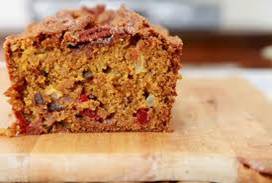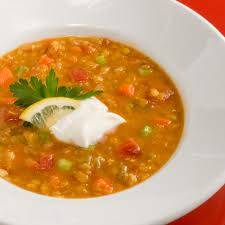
|
NO MORE BLOOD SUGAR BLUES!
Lentil and Split Pea Cookery
by Alice Osborne
 Lentils and dry peas are among the oldest foods cultivated by humankind. In the world market, dry peas and lentils are called “pulses”—that is, seeds that grow in pods on plants that fix nitrogen into the soil.
Beans and chickpeas are also pulses, and they all are members of the legume family, which is gaining more and more recognition for its importance in supplying fiber, complex carbohydrates, protein, and essential nutrients to the diet.
 Dry pea and lentil production in the United States has been centered primarily in one region of the country for about 70 years—a 250-mile long, 50-mile wide band of incredibly rich agricultural land that straddles the border of Washington and Idaho called “the Palouse.” (Roughly translated, that’s French for “green lawn.”)
Farmers in this area grow about 320 million pounds of dry peas and 135 million pounds of lentils annually in crop rotation with wheat and barley. This is my home—I grew up in Spokane, WA, dining on split pea and lentil soups!

Peas and lentils are planted in the spring. Allowed to dry naturally on the vine in the mellow Palouse summer sun, they are harvested in late summer in a mechanical process that separates the pods from the seeds. At the processing plant, lentils are sifted and culled for uniformity in size.
Seeds, field dirt, and other debris are removed by a mechanical process which uses NEITHER water nor chemicals. Therefore, directions for cooking lentils as well as split peas always state to “rinse before cooking” to remove whatever remains of the fine Palouse dust.
Dry peas are processed a bit differently. After being sifted and culled for uniformity in size, they are steamed to remove the seeds coat, and then put into a splitter where the peas are batted with huge paddles that cause them to split along their natural seam. The seed coats are screened off, and the split peas are again sifted and culled. Finally they are “polished” mechanically to produce a clean, uniformly-sized split pea. Dry split peas come in green and yellow varieties.
 These foods are nutrition powerhouses because of their membership in the legume family. They are high in fiber, complex carbohydrates, protein, B-vitamins, and potassium. And to top it off, they have just a trace of polyunsaturated fat, are very low in sodium, and contain no cholesterol.
They are extremely satiating, are nutrient-dense and calorie-sparse, and digest slowly—they are a wonderful food for anyone with blood sugar issues!
The American Institute for Cancer Research recommends “liberal consumption” of lentils and split peas in its dietary guidelines to lower cancer risk. In addition, the American Heart Association recommends increasing intake of high-fiber foods such as lentils and split peas.
I was raised on them and I raised my seven children on them. They are so easy to fix, so versatile, and so tasty. Their mild nutty flavor readily absorbs and harmonizes with spices and herbs, and provides an excellent complement to fish, fowl, beef, pork, and lamb—OR they can be a complete meal in themselves.
And because there’s no chemicals involved in their processing, those from the supermarket aisle are just as healthy as those found in a health food store. You can sprout them, steam them, puree them, toss them in salads, add them to rice and barley, toss them in soups and stews — the list goes on.
I am sharing a couple of my very favorite recipes to get you started if you’re new to lentils and split peas. But first, let’s look at some general cooking guidelines for no-fail results. Keep in mind that results will vary depending on hardness of water, altitude, cooking equipment, or age of the product:
Rinse and drain split peas or lentils
DO NOT SOAK!
Use twice the amount of liquid as split peas or lentils
Salt tends to toughen the seed coat and lengthen cooking time, so add it (if needed), at the end of the cooking time
Pressure cooking is not advised
Dain well for salad recipes
General cooking procedure: In a saucepan, combine split peas or lentils and liquid. Cover; bring to boil. Reduce heat and simmer (15 min. for salads, 30 min. for vegetable and main dish recipes, 45 min. for soups and purees).
Holiday Lentil Bread
(No one will ever guess there are lentils in this!)
 1 C cooked lentils 1 C cooked lentils
1/3 C butter, softened
¾ C sugar
2 eggs
¾ C buttermilk
2 C unsifted flour
½ tsp baking powder
½ tsp baking soda
½ tsp salt
¾ C chopped walnuts or pecans
1 C fresh or frozen cranberries, slightly chopped or whole
1 C golden raisins
Preheat oven to 350 degrees. In mixing bowl, cream butter and sugar. Beat in eggs; blend in buttermilk. Stir in lentils and remaining ingredients, just until blended. Pour into 9x5 inch loaf pan, greased on the bottom only. Bake 50 to 55 min., or until toothpick inserted comes out clean.
 Download this recipe.
Idaho Lentil Bean Pot
Serves 4 Download this recipe.
Idaho Lentil Bean Pot
Serves 4
 1 C lentils
1 onion, chopped
3 garlic cloves, minced
1 sweet pepper (either yellow, orange, red, or green), chopped
6 oz Italian sausage, crumbled
1 can (15 oz) pinto beans, undrained
1 can (15 oz) garbanzo beans, undrained
½ C barbecue sauce
1 C tomato sauce (8 oz)
1 tsp thyme, crushed
1 ½ tsp Italian seasoning
Cook lentils in 2 ½ C water for 30 min. Do not drain. Combine the onion, garlic, sweet pepper, and sausage in a skillet and sauté until onion and pepper are tender and sausage is cooked through. Drain off the fat. Combine the lentils, pinto beans, garbanzo beans, sausage mixture and remaining ingredients in a crock pot. Cook on high for 2 hours or low for 4 hours. Serve with a garnish of fresh parsley and dollop of sour cream. THIS IS SO GOOD!
Contribute to the Cook'n Club!
DVO would love to publish your article, prose, photography and art as well as your cooking, kitchen and nutrition tips, tricks and secrets. Visit the Newsletter Submission / Win Win for All section in our Forum for more information and details.
|
|



